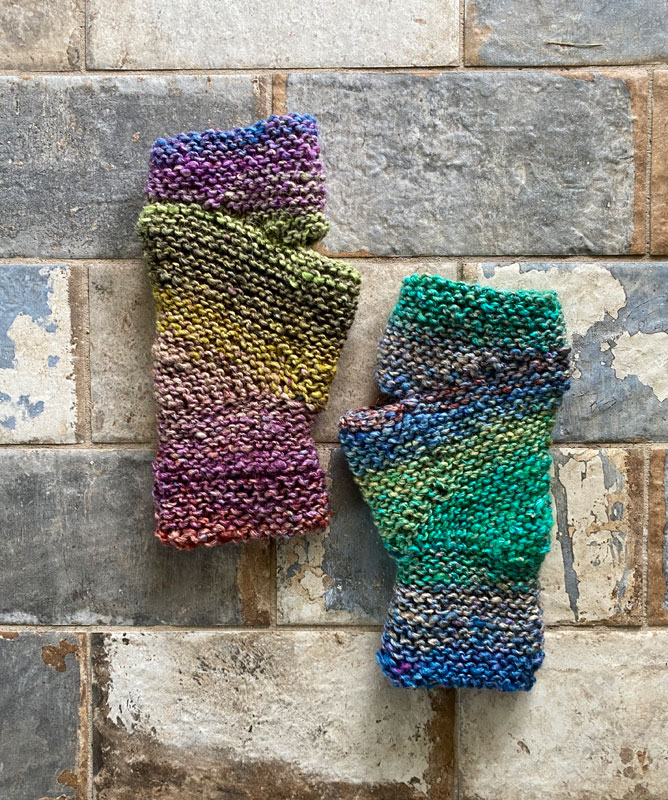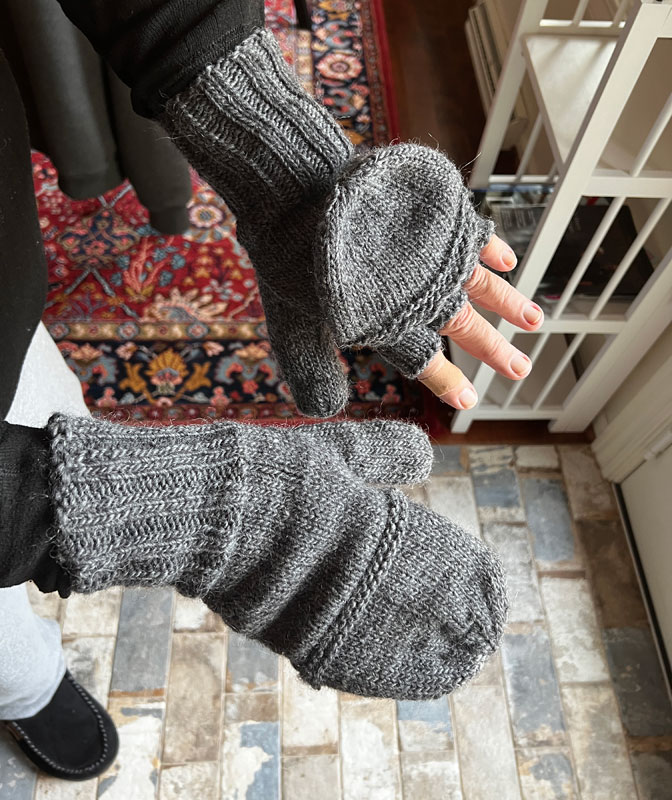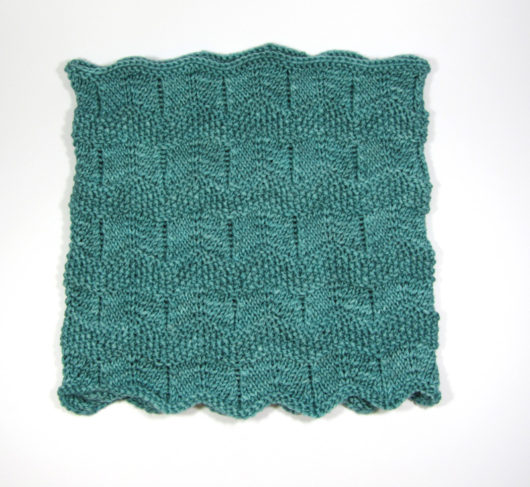
This is Erika Florey’s Callowhill Cowl. Knit in Kelbourne Woolens Scout, a 100% wool DK weight. I’ve knit this cowl once before after Craftsy bundled the pattern and Cloudborn Superwash Merino DK for (basically) 23 cents. OK, not that cheap but very very cheap. I enjoyed the knit but found the yarn wanting. I found the pattern fun to knit, with wonderful texture. But as the pattern is written it’s quite a small circumference cowl. A bit smaller circumference than I’m comfortable with.
This time I knit it with excellent yarn. I’ve not used Scout before but I definitely enjoyed working with it. The stitch definition was great even in this heathered colorway. And, duh, I cast on an extra 16 stitches to add about 3 inches to the circumference. Perfect!

To be sure that my bindoff wouldn’t be too firm, I used a modified version of Jenny’s Surprisingly Stretchy Bindoff (JSSBO). Check out Laura Nelkin’s video on the modification. Basically, you only work the yarn over that’s the defining feature of JSSBO on the knit stitches. You bind off the purl stitches regularly without any added yarn over. Decreasing the number of yarn overs reduces the pesky flare that typically accompanies JSSBO without compromising the needed stretchiness.
I enjoyed the Callowhill knit so much that I decided to cast on for a second cowl almost immediately.

Here it is in Moo Roo Yarns Midnight DK, a 70% merino 30% silk next-to-the-skin soft yarn. This one I’m keeping for me. But working with Moo Roo in this colorway was more of an adventure than I wanted. I’ve never worked with a yarn that leached as much dye as this skein!
As I knit with it, I saw that my white rubbery stitch markers were turning pink. No big deal. I saw the streak of red following where the yarn threaded over my throwing finger. I didn’t realize it was getting all over my hands and fingernails until later but, oh well. Red dye. Indie dyers. After the first evening of working with Moo Roo, I thoroughly washed and rinsed my hands. Then I wiped them on my white hand towel. Big mistake. Pink stains on the towel, which I found in the morning. The next day I completed the cowl. I washed my hands and got out a nail brush. The brush turned red. Major rinse (or so I thought) of everything and again I somehow still managed to stain the fresh white hand towel. Enough already! My mood was turning less forgiving.
Later in the day I went downstairs to wind yarn in my knitting room and saw dust (or so I thought) on my work table. It was red/orange dye! I wiped it away with my hand and my hand was red again. OK…washed that off. This time I dried my hands with paper towel. Final chapter? I came up from the basement the next evening and saw that the white handrail on the stairs was stained with red in places. I know red yarn is especially prone to leaching dye, but this was way too much. The good news is that I used some stain remover on the towels and a deep cycle wash and they emerged unstained. A Magic Eraser got the dye off the handrail.
As for salvaging the cowl, I consulted friends and the internet. I soaked the cowl in a gallon or so of water and a cup of vinegar for 30 minutes. Very little dye leached into the water. After a lot of rinsing to get the smell out I still wasn’t getting any dye out. I believe that I managed to set the dye. And I really do like the final result.
Next up is Laura Aylor’s Four Calling Birds Cowl. I knit it in another new-to-me yarn, Berroco UltraWool DK.

This was Aylor’s 2023 Mystery Knit-a-long that ran from December 13th to the 24th. I don’t often take mystery knit plunges. But I admire Aylor’s work. And how big a commitment would a cowl be anyway? The one cowl pattern provides a knitter with 4 versions: the one you see above, with pleated edging, textured lace, and short rows. An alternate version leaves out the short rows. Another easier version has the pleated edging but uses a simple knit and purl pattern for the body of the cowl. And yet another easy version uses the same simple knit and purl pattern but begins with a simple garter stitch edging. I elected to follow the clues of the pleated, lacy, short row version.
When I found out that the short rows were set up for German short rows, I was tempted to quit. I’d tried them only once before and what resulted wasn’t a pretty sight. But I decided to put on my big girl panties and give the technique another try. Aylor’s directions were excellent on placement of the turns. And Pink’s video helped me greatly. My problems with the pattern weren’t with the short rows at all. Truth be told, the lacework challenged my skill level. But lifelines (which Aylor recommends) and turning off my audiobook came to my rescue.
Here’s a view of the back of the cowl.

I am very pleased with this knit and with the yarn. I asked my granddaughter to model it.

This version of the pattern produces a lovely, feminine cowl. I plan to give some of the more straightforward versions a try soon. And I’ll use Berroco Ultra Wool DK in future projects for sure. Excellent yarn.
This next neck knit has made many appearance on this blog over the years. It’s Lion Brand’s Rib Sampler Scarf. Here’s a link to this freebie courtesy of the Wayback Machine.

I usually make modifications to the pattern to lengthen and widen the scarf. For this version, I used Malabrigo Rios. I increased the width by casting on 44. On the first (and last) section of 2 by 2 ribbing, I knit 10 inches. I followed the pattern and left the garter stitch sections at 4 inches. And I knit 6 inches of mistake rib and farrow rib. I prefer to have the middle of the scarf completely frame the neck so I knit the middle 1 by 1 ribbing for 16 inches.
Laid flat, my version of Rib Sampler Scarf is 60 inches long. Here’s another view.

The weather’s warming up now. It’s supposed to reach 80 degrees Fahrenheit in Grand Rapids, Michigan today. And here I am writing about all these wintry knits. I am oppositional in this way.






























